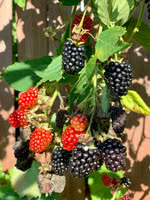Mon-Fri 9am - 5pm Mountain time
Lowbush Cranberry vs Balsors Blackberry
Viburnum edule
Rubus fruticosus Balsors
NOT AVAILABLE THIS SEASON - MIGHT RETURN
COMING SOON
Lowbush Cranberry is a short, deciduous shrub native to North America. Its white flowers bear sour but edible fruit that ripens to a brilliant red in fall. Lowbush Cranberry's small size makes it suitable for urban use; buyers will also find it useful if trying to reclaim land back to its original species or when landscaping with native species in damp conditions.
The Balsors Blackberry is a cold-hardy variety that produces very large, sweet and juicy blackberries late in the summer. They are great for baking and fresh eating.
Balsors Blackberry are floricanes, primarily fruiting on second year canes. Each spring cut back all two-year old canes, leaving only the last year’s growth. This is a self-pollinating variety, so it doesn’t require a second plant nearby to set fruit.

